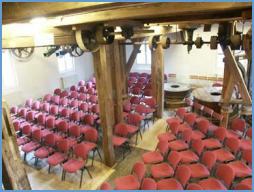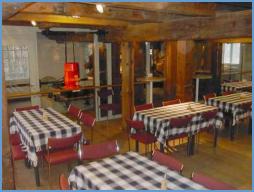Culture Centre Trittauer Watermill
Already for centuries a place of work and encounters.....
.....today a cultural meeting place
with concerts, readings, matinees, exhibitions, recitals and much more in monthly changing
programme.

Today's life in the mill
The watermill Trittau has become the local culture centre of the community Trittau since the renovation and refurbishment ended in the year 1992. The former accounts rooms at the ground floor became exhibition rooms.
There the community Trittau in cooperation with the Kulturstiftung Stormarn of the Sparkasse Holstein presents ongoing visual art exhibitions.
On the first floor of the old working tract an exceptional event room with up to 120 seats was created. The first cultural events of the most diverse kind undertaken by guest organisers as well as the community itself stimulatethis place today. Blues, Jazz, Pop concerts, readings, seminars, recitations, cabaret, matineed and lots more will find here an interesterd audiance. The community Trittau uses this special mill atmosphere also for representative events.
The working tract's ground floor offers a professional furnished kitchen, some adjoining rooms and a bar. This is a great basis for guest and communal organisers for demand catering.
The former living quarter of the miller family at the first floor were turned two apartments. One is rented out to the Kulturstiftung Stormarn, who in turn gives it to an artist as a scholarship on an annual basis. With that and a monthly allowance it gives artists the opportunity to work in a stimulating environment and free of financial constrains.
There were the mill barn stood in the past the Kulturstiftung Stormarn of the Sparkasse Holstein constructed a modern atelier building. It has four ateliers for visual artists.
The watermills' history (summary)
Since ca. 3000 BC people have been using mills, mostly grinding mills. Tradition from the Vikings (ca.800 AD) has it, that they used turning mills with furrows and settings, Karl the Great built water-mills at his palaces.
The Trittauer watermill is located at a place called the 'ante castle' because it has been built where earl Johann von Schauenburg built a palace in 1326 (which had to be pulled down due to disrepair in 1775).
The Trittauer watermill was subject to the mill bondage law from 1654 to 1854. The 'bondage - milling guests' from the surrounding villages were not allowed by high penalty to mill their own grain also they had to help the miller with repairs and with loading and unloading. Following villages were subject to mill bondage: Grande, Witzhave, Lütjensee, Hisdorf, Rausdorf, Sprenge, Kronhorst, Großensee, Ötjendorf, Papendorf, Grönwohld, Hamfelde Köthel, Siek and Trittau.
There was a constant changing of millers due to timed lease contracts in the years 1657 to 1726. The family Holst took over the Trittauer watermill in 1726, from 1760 as long-term building lease. In 1933 there was a compulsory auction for the mill and the company Stoltenberg took it over for 32.000 Mark. In 1973 the community Trittau bought it for 500.000 DM. Recorded the mill as an industrial monument in 1976 and incorporated it into the newly created community's coat of arms in 1982. The renovation work was finely done in 1992. Since November 1992 the turbine wheel, which was constructed at the end of the 19th-century has been worked with a generator, producing electricity.

The mill technique
It is assumed that the watermill worked for many centuries with a vertical undershot waterwheel. It would have been at the sidewall where one can still see a wall penetration today; it is closed up through a wooden cladding. The masticator with two grinding stones was powered by spur wheels, which lay under the grinding stones. Unfortunately drawings or pictures from these times don't exist. Towards the end of the 19th-century the mill got a so-called 'Francis-Turbine'. And under the path between the mill-lake and the mill a ditch was created. The water, which ran through it, powered and still powers the under the building situated metal horizontal turbines. At that time the Masticators were still powered by direct drive. Today if the water level is right the turbine is being powered by a generator. The industrial revolution didn't pass by the mill in the meantime. Being tired of the dependent on the water level and several disagreements about the damming up rights let the family Holst to built a stable annexe to house the steam engine to power the mill and a third masticator in 1850.
During the First World War electric power was installed for the masticators, which was renewed in 1939 because at that time there was once again a water shortage in the pond.
Generating electricity
The original 'Francis-Turbine' was reconditioned in 1992. Then a generator was installed where still old parts of the original grinder were conserved. The generator was connected to the turbine with flat drive belt.
The generator with an actual power output of ca. 20 kW is being connected to the turbine via a belt pulley with a drive shaft. The generated electricity is being fed into the Schleswag network via a switchboard, if not needed for the mill.

